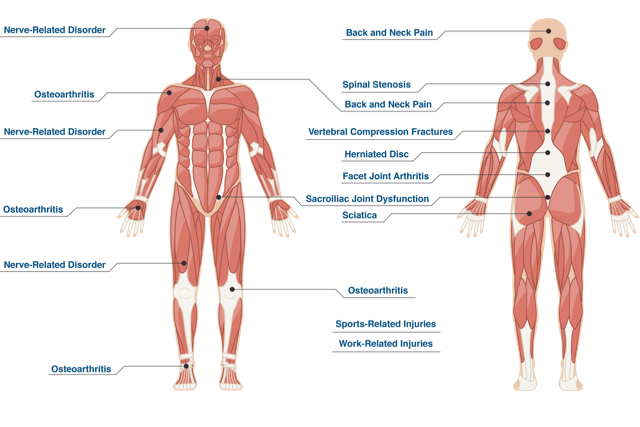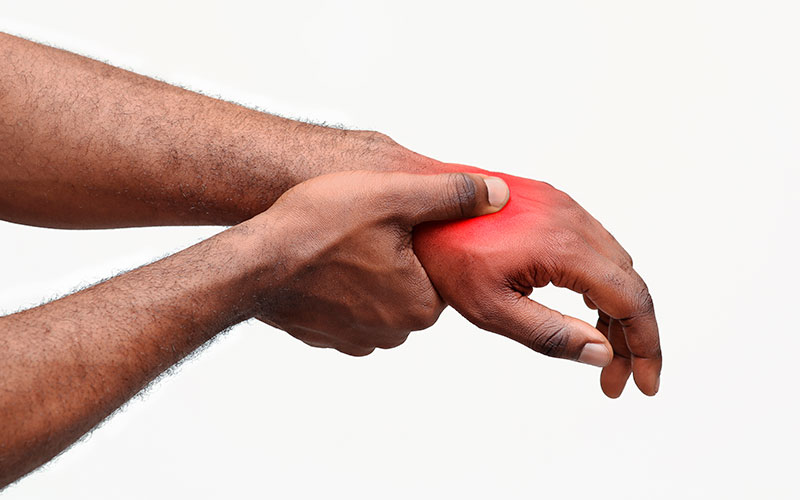
Back and Neck Pain
For pain relief, injections can be more effective than an oral medication because they deliver medication directly to the anatomic location that is generating the pain.

For pain relief, injections can be more effective than an oral medication because they deliver medication directly to the anatomic location that is generating the pain. Typically, a steroid medication is injected to deliver a powerful anti-inflammatory solution directly to the area that is the source of pain. Depending on the type of injection, some forms of low back pain relief may be long lasting and some may be only temporary.
Facet Joint Arthritis
Facet joints are small joints at each segment of the spine that provide stability and help guide motion.

Facet joints are small joints at each segment of the spine that provide stability and help guide motion. The facet joints can become painful due to arthritis of the spine, a back injury, or mechanical stress to the back.
A cervical, thoracic or lumbar facet joint injection involves injecting a small amount of local anesthetic (numbing agent) and/or steroid medication, which can anesthetize the facet joints and block the pain. The pain relief from a facet joint injection is intended to help a patient better tolerate a physical therapy routine to rehabilitate his or her injury or back condition.
Herniated Disc
A cervical herniated disc is diagnosed when the inner core of a disc in the neck herniates, or leaks out of the disc, and presses on an adjacent nerve root.
A cervical herniated disc is diagnosed when the inner core of a disc in the neck herniates, or leaks out of the disc, and presses on an adjacent nerve root. It usually develops in the 30-to-50-year-old age group. While a cervical herniated disc may originate from some sort of trauma or neck injury, the symptoms commonly start spontaneously.
The arm pain from a cervical herniated disc results because the herniated disc material “pinches” or presses on a cervical nerve, causing pain to radiate along the nerve pathway down the arm. Along with the arm pain, numbness and tingling can be present down the arm and into the fingertips. Muscle weakness may also be present.
The discs in the cervical spine are not very large; however, there is also not a lot of space available for the nerves. This means that even a small cervical disc herniation may impinge on the nerve and cause significant pain. The arm pain is usually most severe as the nerve first becomes pinched.
Treatment
Injections. Cervical Epidural steroid injections or selective nerve root blocks can be helpful to reduce inflammation in cases of severe pain from a cervical herniated disc, and can be very effective if accompanied by a comprehensive rehabilitation program that may involve a number of the above treatments.
Facet joints are small joints at each segment of the spine that provide stability and help guide motion. The facet joints can become painful due to arthritis of the spine, a back injury, or mechanical stress to the back.
A cervical, thoracic or lumbar facet joint injection involves injecting a small amount of local anesthetic (numbing agent) and/or steroid medication, which can anesthetize the facet joints and block the pain. The pain relief from a facet joint injection is intended to help a patient better tolerate a physical therapy routine to rehabilitate his or her injury or back condition.
Medications injected may include steroids, local anesthetics, and opioids:
- Steroid injections may reduce the inflammation and irritation to that nerve and reduce pain.
- Local anesthetics may also break the cycle of pain and provide some relief of the patient’s chronic pain
- Opioid injections also provide powerful, short-term pain relief.
By reducing irritation, the injections may help the affected nerve, or nerves, heal. Having a nerve block may also improve symptoms enough for the person to take a more active part in physical therapy.
Nerve blocks are used to target pain throughout the body, such as back, neck, head, shoulder, or leg pain. If back pain is the problem, an epidural pain block may be recommended. In an epidural nerve block, a corticosteroid medication is injected into the area around the spinal column known as the epidural space.
Nerve blocks are generally most effective when a small number of nerves-or a single nerve-is causing pain. Pain relief is usually immediate. The duration of pain relief varies with the individual, and some people have injections every few months. Pain blocks are typically administered in an outpatient procedure.